Now I was always intrigued by clocks, even from a young age.
A few years ago, I came across an old report card that was issued during my tenure in kindergarten. In the report, the teacher made a comment that one day I had somehow gotten my hands on a box of "broken" alarm clocks - which were being used to teach us how to tell time - and somehow I had managed to get those clocks to work again. Which was pretty amazing except for the fact that I had somehow managed to make the alarms go off during nap time!
Needless to say, I always found timepieces interesting, as evidenced by previous projects that I've posted.
A few months ago I posted a little tutorial on how to turn wooden bowl blanks on a lathe.
Well, I got sidetracked a little bit with some other projects, but the lathe was starting to look a little lonely so I figured that I should give it a little love and try making something with it again.
The project that I settled on was basically an extension of the bowl blank, but with some extra touches including rounding the edges of the blank and cutting a groove into the face.
The spark of this project was due to some more experimentation that I was doing with the Cricut Maker where I wanted to see how the Maker handled fine detail work on wood veneer.
So, being a creature of habit, I decided to build a clock using the Maker and my lathe.
I started the project by gluing together a series of 1-inch thick hardwood strips so that I had a 7" X 7" board.
I could have used a solid piece of wood for the clock, but I had some leftover pieces of wood from other projects that were from different wood species and I wanted to create a nice color effect with this clock.
When gluing the wood together, I make doubly sure that the joints were well glued and clamped as tightly as possible - while this would certainly ensure that there were no gaps in the joints, this was more due to a safety concern - I just didn't want to risk the possibility of having things fly apart while spinning at high speed on the lathe.
When the glued dried I then placed a straight edge on each diagonal corner of the wood piece and drew a straight line from corner to corner so that I had a large X drawn on the wood.
The purpose of the X was to identify the center of the wood in order to make the mounting of the faceplate for the lathe much easier.
With the X marking the spot, I then placed the wood piece my table saw jig (which I covered back in my bowl blank post) and cut the corners off the wood so that the piece was in more of an octagon shape.
Next, I took the faceplate for my lathe and placed it on the wood so that the center of the X was more or less in the center hole of the faceplate.
I then secured the wood to the faceplate with some half-inch screws.
I then mounted the piece on the lathe and I started its transformation into a clock by taking off the sharp edges of the wood with a rough gouge.
I kept turning with the rough gouge until the outside edge of the wood started to become more of a round shape.
Switching over to my bowl gouge, I kept turning until the wood piece was a perfect circle.
With the outside of the wood turned I then switched the tool rest over to face the face of the wood and again with the bowl gouge, I then leveled out what will become the face of the clock
Next, I made another adjustment of the tool rest and I rounded over the outside edge of the clock face with the bowl gouge.
With the front edge rounded over, I did the same again for the back of the clock.
As an extra bit of flair, I also added a bit of a taper to the clock's back.
In the end, I had a disk that was about six inches in diameter.
With the basic shape of the clock made, the next step in the process was to add a recess into the face of the clock to serve as a mounting point for the numbers that I will be adding later.
To add the groove I first needed to mark out the locations that I need to make my cuts on the clock's face.
The numbers are going to be approximately 1 inch in height.
I removed the clock from the lathe and I started by first making a pencil mark about 4 inches in from the edge of the clock's face followed by another mark at 5 inches.
Reinstalling the clock face on the lathe I then placed my pencil on the two marks on the clock face, and by turning the lathe at low speed, I drew 2 circles at the two marked spots.
Using a shear scraper chisel, I then cut a 1/8 inch groove at each circle that I had drawn on the clock's face
Returning to the bowl gouge I then trimmed away the wood between the two grooves that I had just cut until I had a larger groove cut into the clock face that was 1 inch wide and 1/8 inch deep.
Once I had cut the wood down to the same depth as the grooves I then used a skew chisel to make sure that the groove was as flat as possible.
After a quick sanding, the clock face was ready for the next step.
I removed the face from the lathe and removed the faceplate from the clock.
Returning to the Cricut Maker, I next worked on creating the numbers to put on the clock's face.
I first looked for a clip art image of a clock face that would allow the numbers to be pre-placed in the proper order in order to make attaching the numbers to the clock face as easy as possible.
After some searching, I settled on a clock face that comprised of numerical numbers that are attached with a circle at each end of the numbers.
I loaded down the imager to the Cricut Design tool, loaded in a sheet of maple veneer into the Maker and cut out the clock numbers.
Once the numbers were cut out I did need to trim out some of the finer parts with a Xacto knife.
Before I attached the numbers to the face of the clock I figured that I should probably get the mounting for the clock movement sorted out first.
Returning to the wooden clock face, I drilled a 3/8 inch hole in the center of the clock's face. Finding the center of the face is actually pretty simple since there will be a distinct tool mark in the center of the face from the bowl gouge,
Once the hole has been drilled, I did an initial test fit of the clock movement by putting the shaft through the hole in the clock face.
In an ideal situation, the shaft of the clock movement should extend out of the hole a couple of centimeters, or at least far enough so that the movement could be secured to the clock face by tightening the supplied nut to the movement's shaft.
In my particular case, I needed to remove about a half-inch of material from underneath the clock movement.
To mark the area that I needed to trim I flipped the clock over so that its back faced up and I positioned the clock movement the spot on the back of the clock that I where I wanted it installed.
Next, I drew an outline of the movement on the wood.
Using my Dremel Trio with a straight bit set to a depth of 1/2 inch, I then cut out a cavity in the back of the clock inside the outline that I had drawn.
A quick test fit ensured that I had the needed clearance on the front of the clock to secure a nut on the clock's shaft.
With the placement of the movement sorted out, it was time to add the numbers to the clock face.
To attach the numbers I flipped the numbers over so that the back of the numbers were facing up and applied a light coat of contact cement to them.
Flipping the numbers right side up, I then attached the numbers to the clock face. When I installed the numbers I made sure that the numbers were in line with the mounting for the clock movement (the reason for this is that when the clock is hung up on the wall, it will look "proper" with the number 12 at the top)
The numbers were mounted into the groove on the clock face by applying firm pressure.
Once the cement cured, I applied a couple of coats of varnish to the clock,
Once the varnish dried, I just permanently attached the clock movement to the clock face by tightening up the nut on the shaft and attaching the hands to the clock.
Inserting a battery into the clock movement started it ticking.
Now the clock is hanging on the wall in my office at work. Thanks to it, I'm now no longer later for meetings!



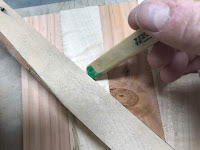
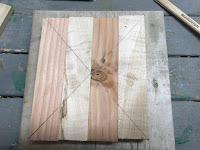




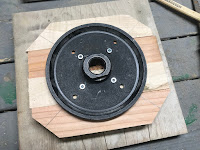

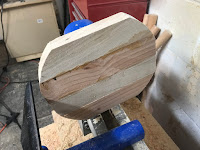


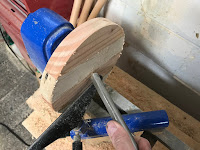






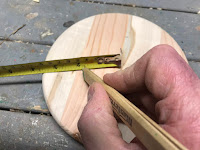








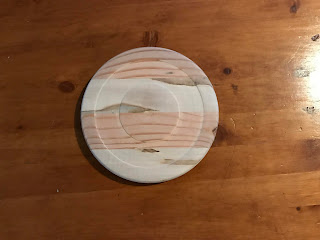


















No comments:
Post a Comment